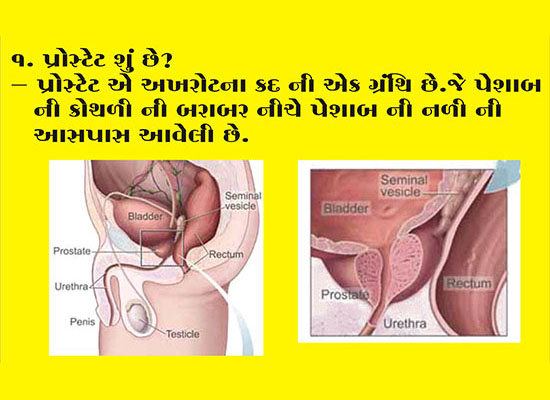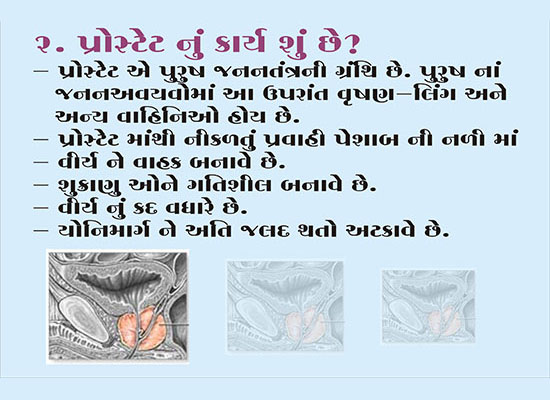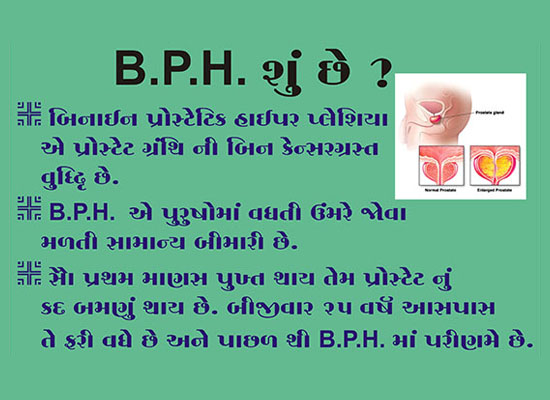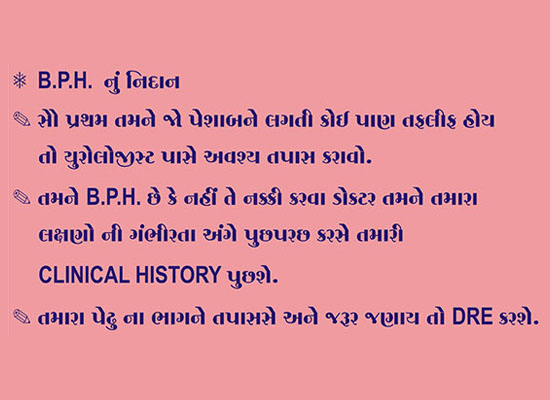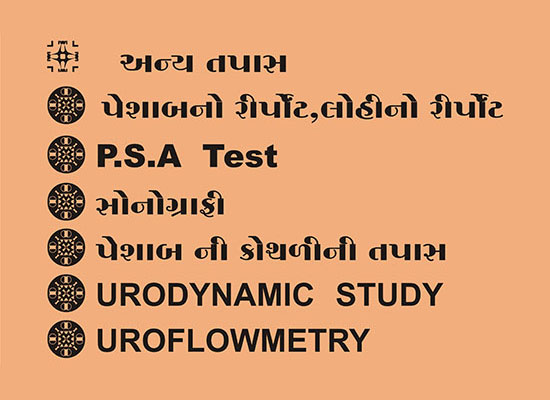Prostate BPH
Symptoms:
Most men eventually develop some prostate enlargement as they age. About half of these men develop lower urinary tract symptoms that are so bothersome they seek medical treatment. Your symptoms may be caused by obstructed urine flow or by an irritated bladder or urethra, or you may have a combination of these problems.
Common signs and symptoms include:
- Weak urine stream.
- Difficulty starting urination.
- Stopping and starting again while urinating.
- Dribbling at the end of urination.
- Frequent need to urinate.
- Increased frequency of urination at night (nocturia).
- Urgent need to urinate.
- Not being able to completely empty the bladder.
- Blood in the urine (hematuria).
- Urinary tract infection.
The Prostate symptoms self-assessment is one way to measure urinary symptoms, but having lower urinary tract symptoms doesn't mean you have BPH. The symptoms can have other causes besides an enlarged prostate. Only your doctor can determine if BPH is causing your symptoms. See your doctor if you're having any urinary problems.
Complications of BPH
- Acute urinary retention (AUR). AUR is a sudden painful inability to urinate. To empty the bladder, a catheter must be inserted into the bladder through the penis.
- Urinary tract infections (UTIs). These infections inflame the urethra and bladder and cause painful urination.
- Bladder stones
- Kidney damage. This is caused by frequent infections and acute urinary retention.
What causes BPH?
Doctors aren't sure exactly what causes BPH. It's thought that with age, changes in the ratio of male (testosterone) and female (estrogen) hormone levels in men stimulate the prostate to grow. Another theory is that with aging, the prostate gland becomes more sensitive or responsive to normal levels of male hormone and grows more rapidly.
Who gets BPH?
BPH severe enough to cause bothersome urinary symptoms is common in older men. Age seems to be the primary risk factor. It's rare in men age 40 and younger, but half the men in their 60s have BPH symptoms. These symptoms generally worsen with age. Up to 90 percent of men in their 70s and 80s have prostate gland enlargement. A family history of BPH slightly increases your chances for the condition.
Diagnosing BPH
To diagnose BPH, your doctor will review your medical history and do a physical exam and then may arrange for you to have one or more tests.
As a rule, the shorter the stricture, the greater the chance of a cure with dilation. It is a relatively easy procedure to do and so may be tried first.
Tests and exams used to diagnose BPH
History: Symptoms you are having, including difficulty in passing urine, stream, frequency, etc. Digital rectal exam. Wearing a lubricated examination glove, your doctor gently inserts a finger into your rectum. Your doctor checks the size, texture and shape of the gland. This allows your doctor to determine whether your prostate is enlarged and to help rule out prostate cancer.
Urine test. Analyzing a sample of your urine in the laboratory can help rule out an infection or other conditions that cause BPH-like symptoms, such as temporary inflammation of the prostate (prostatitis), bladder infection and kidney disease.
Tests your doctor may use to help confirm BPH diagnosis
Symptom questionnaire. The American Urological Association (AUA) BPH Symptom Score Index asks you how severely and how frequently you have specific urinary symptoms. It's one way to monitor if your symptoms are getting worse over time. You can check your urinary symptoms by completing the Prostate symptoms self-assessment.
Prostate-specific antigen (PSA) blood test. It's normal for your prostate gland to produce PSA, which helps liquefy semen. A small amount of PSA normally circulates in your blood. Higher than normal levels in your blood can indicate you have BPH, prostate cancer or prostatitis. Most physicians use this test in men with BPH to be sure that a hidden prostate cancer isn't missed.
Urinary flow test(uroflowmetry). This test measures the strength and amount of your urine flow. You urinate into a receptacle attached to a special machine. The test takes no longer than a normal urination. Charting the results of this test over time helps determine if your condition is getting better or worse. It's normal for peak urine flow to decrease with age, but it can also be a sign of BPH or a weakened bladder muscle. After passing urine, your residual urine is checked o n ultrasound machine.
Urodynamic pressure-flow studies. This test measures bladder pressure and function while you urinate. After you receive a local anesthetic, a small catheter is threaded through your urethra into your bladder. Water is slowly injected into your bladder to measure internal bladder pressure and to determine how effectively your bladder contracts. Bladder pressure and urinary flow may be measured while you urinate. The test takes 30 to 60 minutes. Generally this test is reserved for men with complicated or unusual urinary symptoms.
Treatment Options
Most men who seek treatment do so because they're bothered by lower urinary tract symptoms. All BPH treatments attempt to reduce the severity of symptoms and restore the normal function of the urinary system. Different treatments provide different degrees of relief. How severe your symptoms are and how bothered you are by them are key to deciding which treatment option is best for you. Depending on how large your prostate is, and the location of excess prostate tissue, some treatment options may be more appropriate than others.
- Watchful waiting
- Lifestyle changes to reduce symptoms
- Medications
- Surgery
- Transurethral resection of the prostate
- Transurethral incision of the prostate
- Open prostatectomy
- Pros and cons of surgery
Medications are the most common way to control mild to moderate symptoms of BPH. They're the preferred way to treat BPH, unless your condition is severe enough to require surgery. Medications significantly reduce major symptoms for about two-thirds of men who try them. If medications don't work, a minimally invasive treatment or surgery may be the best option.
he two types of medications currently used to treat BPH are alpha blockers and enzyme inhibitors. Alpha blockers relax muscles around the neck of your bladder, which makes it easier for urine to flow through your urethra. Enzyme inhibitors shrink the size of your prostate gland. Sometimes the two types of drugs are prescribed in combination.
Alpha blockers
Alpha blockers relax muscles around your bladder neck and make it easier to urinate.
Who they work best for. Alpha blockers are most effective for men with normal-sized to moderately enlarged prostate glands. Alpha blockers were originally created to treat high blood pressure (hypertension). For this reason, they can be an especially appropriate choice for men who also have hypertension. These medications aren't for you if you already have BPH complications, such as significant urine retention and frequent urinary tract infections. Alpha blockers don't effectively treat these conditions.
Outcome. Alpha blockers relieve symptoms in many men who take them. They work quickly. Within a day or two, you'll probably have increased urinary flow and need to urinate less often. Many men have a significant decrease in their urinary symptom index score and improved quality of life.
Side effects. Side effects are generally mild and controllable. The most common side effects of alpha blockers include:
- Reduced semen released during ejaculation
- Low blood pressure
- Dizziness
- Headache
- Stomach or intestinal irritation
- Stuffy or runny nose
Medications are the most common way to control mild to moderate symptoms of BPH. They're the preferred way to treat BPH, unless your condition is severe enough to require surgery. Medications significantly reduce major symptoms for about two-thirds of men who try them. If medications don't work, a minimally invasive treatment or surgery may be the best option.
he two types of medications currently used to treat BPH are alpha blockers and enzyme inhibitors. Alpha blockers relax muscles around the neck of your bladder, which makes it easier for urine to flow through your urethra. Enzyme inhibitors shrink the size of your prostate gland. Sometimes the two types of drugs are prescribed in combination.
Enzyme (5-alpha-reductase) inhibitors
These drugs shrink your prostate gland. Two have been approved by the FDA for BPH:
- Finasteride (Finast)
- Dutasteride (Dutas, Dutagen, etc)
- Both drugs are equally effective. They cost more than alpha blockers.
Enzyme inhibitors reduce the amount of testosterone that turns into dehydrocorticosterone (DHT), a hormone required for prostate gland growth.
Who they work best for. Enzyme inhibitors are most effective for men with larger or moderately enlarged prostate glands.
Outcome. Enzyme inhibitors take longer to work than alpha blockers do. You may notice some urine flow improvement after a few months, but it can take up to a year for complete results. In men with moderate to severe BPH, enzyme inhibitors may significantly decrease the need for surgery and the incidence of urinary retention.
Finasteride and dutasteride lower PSA levels in your blood. Your doctor needs to know that you're taking finasteride or dutasteride to properly interpret your PSA test results.
Side effects. Side effects of enzyme inhibitors are generally rare and can include:
- Erection problems
- Decreased sexual desire
- Reduced semen release during ejaculation
These side effects may go away when you stop taking the drugs, or after the first year of taking them. Finasteride is the active ingredient found in the drug Propecia, which is used to prevent hair loss — often a side benefit when taking finasteride for BPH. Finasteride can be taken with medications for erectile dysfunction.
Combination drug therapy
Aking an alpha blocker and an enzyme inhibitor at the same time can sometimes be more effective than taking just one type of BPH drug. Combination therapy can be more effective for relieving symptoms and preventing your symptoms from getting worse. It can also be more effective at lowering your long-term risk of developing acute urinary retention or needing surgery.
Who it works best for. Men whose symptoms are likely to worsen may benefit most from combination therapy, compared with single-drug therapy. These include men with larger prostates.
Transurethral Resection Of The Prostate
Transurethral resection of the prostate (TURP) is a procedure frequently used to treat moderate to severe BPH. It was one of the most common major surgeries performed on men age 65 and older but is rapidly being replaced by laser prostatectomy and other less invasive procedures.
What to expect. After you're given a spinal or general anesthetic, an instrument called a resectoscope is inserted into your urethra through your penis.
During the 60- to 90-minute operation, your surgeon uses the scope's wire loop to remove obstructing tissue one piece at a time obstructing tissue one piece at a time from the inside of your gland, creating a cavity. Only the interior part of your gland is removed. This tissue is carried by the irrigating fluid into the bladder, and then flushed out at the end of the operation. Expect some blood or small blood clots in your urine afterward. You'll probably need a urinary catheter for a few days. At first, you may have painful urination or a sense of urgency as urine passes over the surgical area. This gradually improves over one to four weeks. You can go back to office work in about two weeks and back to manual labor in four to six weeks. You can resume sexual activity in four to six weeks.
Who it works best for. TURP greatly relieves lower urinary tract symptoms in nearly all men. It produces the greatest symptom relief in men who have larger prostate glands and more bothersome symptoms. Even men with severe bladder damage caused by BPH often improve after TURP.
Outcome. TURP relieves symptoms quickly. Most men experience a stronger urine flow within a few days.
Side effects. TURP can cause excessive bleeding, though this is rare with modern surgical techniques. Frequent urge to urinate is common during the early recovery period, but is rare long term about the same frequency as occurs in men who choose watchful waiting.
TURP syndrome occurs when your bloodstream absorbs too much of the irrigating solution, causing abnormally low concentrations of sodium in your blood. It rarely occurs anymore due to current surgical techniques and is readily treated.
Prolonged side effects of TURP may include:
- Semen entering your bladder (retrograde ejaculation)
- Erection problems
- Painful urination
- Recurring urinary tract infections
- Bladder neck narrowing (stricture)
- Blood in your urine (hematuria)
Need for re-treatment. Later treatment after TURP is uncommon and significantly less likely, compared with minimally invasive treatments. Some men may need a second surgery after a number of years. A few men require re-treatment because their prostate gland regrows or because not enough of it is removed the first time.
Newer Tequniqes like HOLAP, HOLEP, HOLRP are more effective & durable for details see other page.

